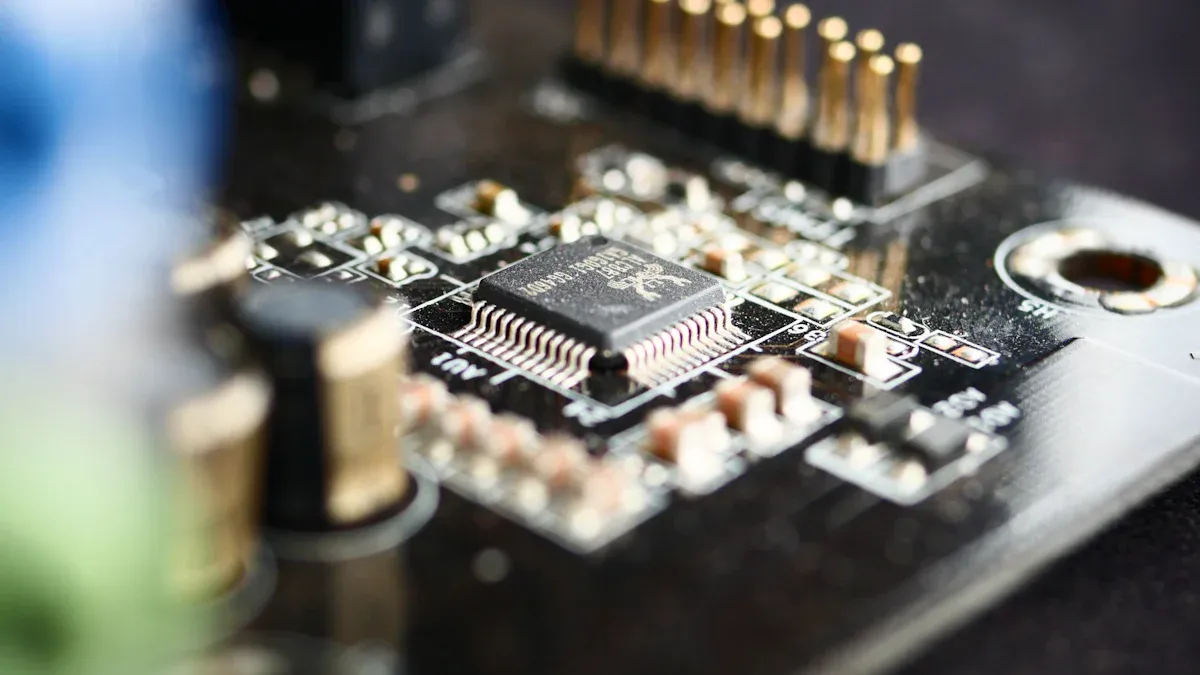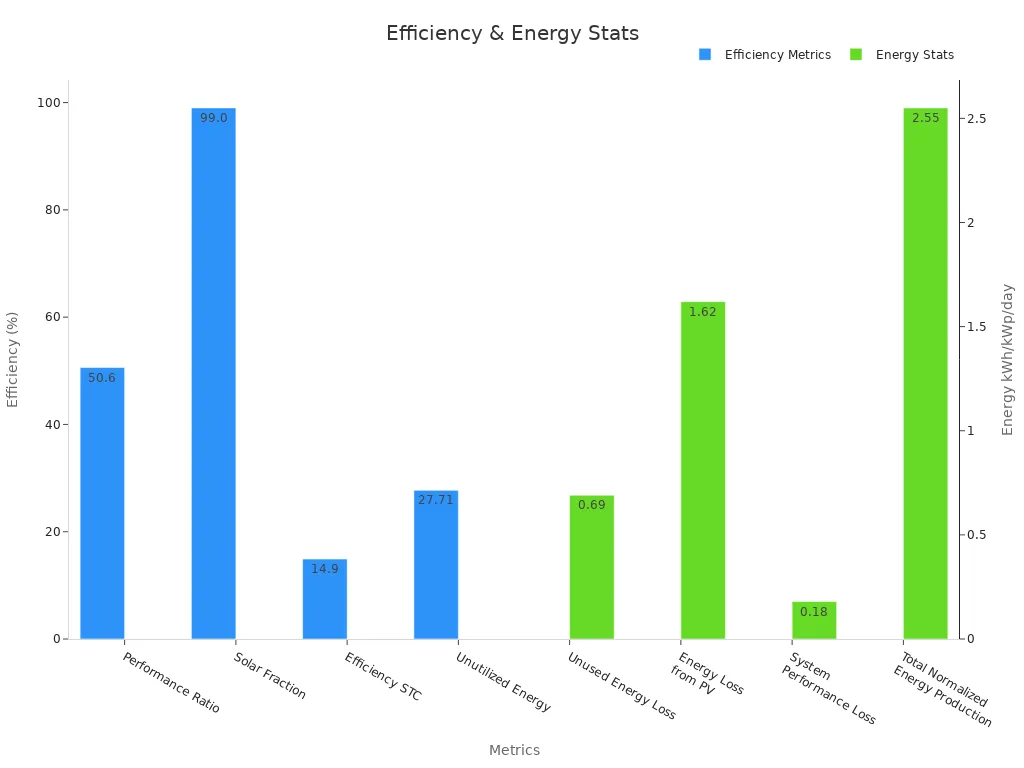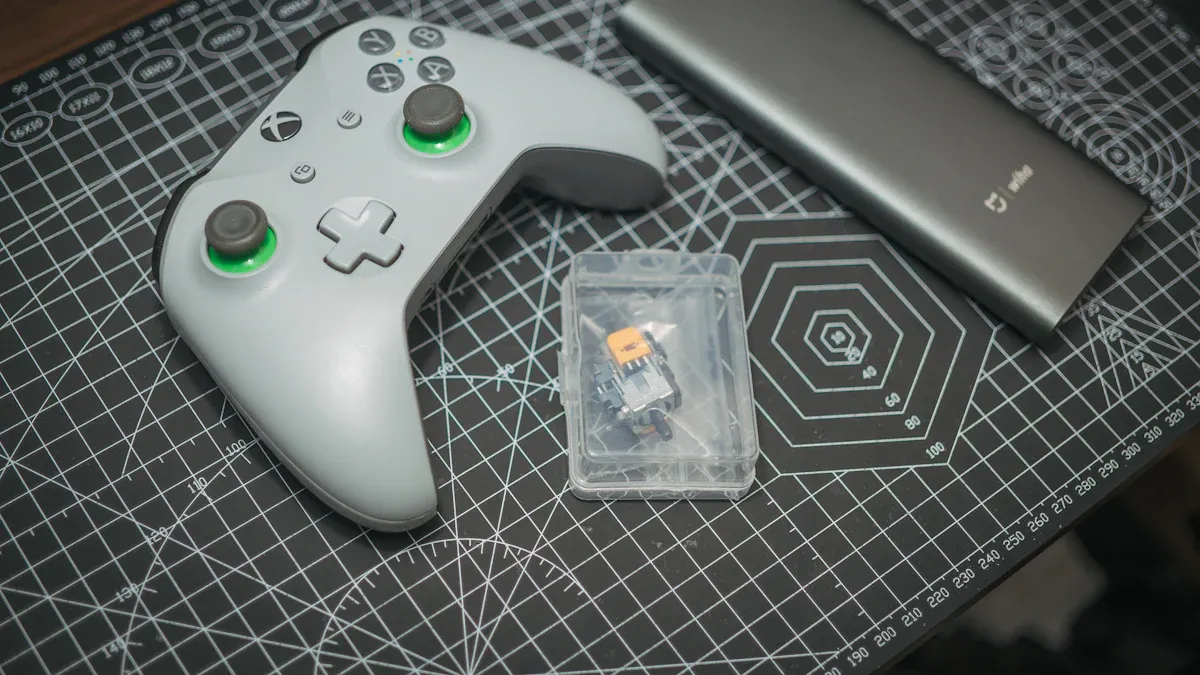MCP73826 or Others? Find Your Perfect Match
Choosing a good battery charger controller is important. The MCP73826 is known for being efficient and flexible. It works well with single-cell batteries and saves energy. This makes it great for portable devices or low-cost projects. But, the best choice depends on what you need. Learn about the MCP73826 to see if it’s right for you. If not, another option might work better.
Key Takeaways
The MCP73826 is a small battery charger perfect for portable gadgets.
It charges single-cell lithium-ion and lithium-polymer batteries well, saving power.
Safety features like overcharge protection keep charging safe and reliable.
The MCP73826 is affordable, making it great for small projects or DIY tasks.
For bigger power needs or multi-cell batteries, try controllers like the BQ24072.
Always pick a charger that fits your battery and project needs.
The MCP73826 makes design easier by needing fewer extra parts, saving time.
Check efficiency, compatibility, and safety when choosing a battery charger.
Overview of MCP73826

Key Features
Small size and compact design
The MCP73826 is made for portable devices. It comes in a tiny 6-pin SOT-23A package. This small size makes it perfect for gadgets with limited space. You can easily use it in wearables or handheld devices.
Saves energy and works efficiently
This controller reduces energy waste while charging batteries. It delivers power efficiently and has a voltage accuracy of ±1%. This helps batteries last longer by avoiding extra power use.
Works with single-cell Li-Ion/Li-Polymer batteries
The MCP73826 is designed for single-cell lithium-ion and lithium-polymer batteries. It supports preset voltages of 4.1V and 4.2V. You can also adjust the charge current, making it useful for many projects.
Benefits
Makes portable device design easier
The MCP73826 simplifies creating portable devices. It has built-in features like automatic preconditioning and adjustable charge current. These features reduce the need for extra parts, saving time and effort.
Affordable for small projects
This controller is a low-cost option for small projects. It is accurate, reliable, and budget-friendly. Whether for DIY or commercial use, it offers great value.
Built-in safety for reliable use
Safety is important when managing batteries. The MCP73826 includes features like overcharge protection and thermal regulation. These ensure safe and dependable operation, even in tough conditions.
Tip: The MCP73826 is a safe choice for charging batteries in portable devices.
Limitations
Only for single-cell batteries
The MCP73826 is made for single-cell lithium-ion batteries. If you need multi-cell support, you’ll need a different option.
Not ideal for high current needs
The MCP73826 allows adjustable charge current. However, its design isn’t efficient for high currents. This makes it less suitable for fast charging or high-power needs.
Not for industrial or high-power uses
The MCP73826 isn’t great for industrial or high-power projects. Its input voltage is 4.5V to 5.5V, and it works best between -20°C and +85°C. It’s not ideal for extreme conditions.
Specification | Details |
|---|---|
Input Voltage Range | 4.5V to 5.5V |
Ambient Temperature Range | -20°C to +85°C |
Efficiency | Lower due to linear design |
Thermal Management Consideration | Important because of low efficiency |
If your project needs better efficiency or works in extreme conditions, look for other battery controllers.
Comparison Criteria for Battery Charger Controllers
Efficiency
Why saving energy matters
Picking a charger with high efficiency is very important. It helps save energy during charging and reduces wasted electricity. Less wasted energy means less heat, which protects the battery. For example, a charger with a performance ratio (PR) of 0.506 and efficiency of 14.90% under standard conditions shows average energy saving.
Metric | Value |
|---|---|
Performance Ratio (PR) | 0.506 |
Efficiency under STC | 14.90% |
Unutilized Energy | 27.71% |
How efficiency helps batteries last longer
Efficient chargers make batteries last longer. They stop overcharging and protect the battery’s parts. Inefficient chargers waste energy, which can harm performance. For instance, unused energy loss (Lu) can be 0.69 kWh/kWp/day, and PV energy loss (Lc) can reach 1.62 kWh/kWp/day. These losses lower how well your battery system works.

Compatibility
Matching chargers to battery types
Not all chargers work with every battery type. Some are made for lithium-ion or lithium-polymer batteries. Others can handle different types. If you use multiple cells, make sure the charger fits your battery type. This keeps charging safe and avoids damage.
Voltage and current needs
Batteries need specific voltage and current to charge properly. A good charger matches these needs to avoid problems. For example, single-cell lithium-ion batteries need 4.2V. If you use multiple cells, pick a charger with adjustable voltage and current.
Cost
Finding the right balance
Cost matters when picking a charger. Budget-friendly options like the MCP73826 are great for small projects. But they may not have advanced features. More expensive chargers offer better safety and efficiency, which can be worth the price.
Saving money over time
An efficient charger can save money in the long run. It reduces wasted energy and helps batteries last longer. For example, systems with a solar fraction (SF) of 0.990 or more use energy better. This lowers waste and cuts electricity costs.
Safety Features
Protection from overcharging and too much current
Keeping batteries safe is very important when charging them. Too much charge or current can harm the battery or cause danger. Controllers like the MCP73826 have safety features to stop this. They check voltage and current to keep them safe. This stops the battery from overheating or swelling, which can break it.
Safety features are key in managing batteries. They stop dangerous problems during charging or use. For example:
Watching voltage, current, and heat keeps them in safe limits.
Low voltage settings protect lithium-ion batteries from harm.
These steps lower the chance of thermal runaway, where batteries overheat badly.
Managing heat for safety
Controlling heat is also very important for battery safety. Batteries get hot when charging. Without good heat control, this heat can hurt the battery or nearby parts. The MCP73826 has heat control to keep temperatures safe. This helps it work well, even in tough places.
Rules like ISO 26262 stress heat control in car electronics. They rank risks by safety levels, with the highest needing extra care. Following these rules keeps your battery system safe and working well.
Needs for Specific Uses
Portable vs. industrial uses
The right charger depends on how you’ll use it. Small devices like wearables need tiny, light chargers. The MCP73826 is great for these because it’s small and efficient. But factories need stronger chargers with more safety features. For these, you’ll need a charger for bigger batteries or harsh conditions.
A study on GPS trackers shows how needs affect choices. Adding solar power made GPS systems work better in hard conditions. Picking the right charger can improve performance and meet special needs.
Space and design limits
Small devices often have little room for parts. A tiny charger like the MCP73826 fits well in tight spaces. Its small 6-pin design is perfect for compact gadgets. But factory systems may focus on features, not size. They can use bigger chargers with more power or multi-cell support.
When planning your project, think about space and design needs. The right charger will make your battery system work well without hurting the design.
MCP73826 vs. Other Popular Controllers

MCP73826 vs. MCP73831
Battery types they support
The MCP73826 works only with single-cell lithium-ion batteries. This makes it great for small gadgets needing simple battery setups. The MCP73831, however, supports both lithium-ion and lithium-polymer batteries. This gives it more flexibility for different projects. If you only need single-cell lithium-ion support, the MCP73826 is a better fit.
Comparing cost and energy use
The MCP73826 is cheaper and good for budget projects. It works well without being too complicated. The MCP73831 costs more but can save more energy in some cases. If saving energy matters more than price, the MCP73831 is better. But for small projects, the MCP73826 balances cost and features well.
MCP73826 vs. TP4056
Why TP4056 is great for DIY
The TP4056 is popular with hobbyists and DIY makers. It’s simple to use and easy to find. It has a micro-USB port, making charging setups easier. For DIY projects needing a basic charger, the TP4056 is a good pick.
MCP73826’s strength in small designs
The MCP73826 is better for tiny, space-limited designs. Its small size and good heat control make it ideal for compact gadgets. It also has safety features to keep batteries safe. If you need a small, reliable charger, the MCP73826 is a great choice.
MCP73826 vs. BQ24072
BQ24072 for high-power needs
The BQ24072 is made for bigger, high-power projects. It handles higher voltages and has advanced features like power path management. This lets it charge and power devices at the same time. For high-power or multi-cell setups, the BQ24072 is the better option.
MCP73826 for simple single-cell use
The MCP73826 focuses on being simple and efficient for single-cell batteries. It skips extra features to stay affordable and easy to use. This makes it perfect for small gadgets or portable devices. Its small size and safety features ensure it works well for everyday needs.
MCP73826 vs. MCP73833T
MCP73833T’s ability to charge and power devices at once
The MCP73833T has a special feature called power path control. This lets it charge a battery while powering a device at the same time. For example, smart home devices that must always work benefit from this. It manages power smartly between the battery and the device. When the device isn’t in use, it focuses on charging. When needed, it switches to powering the device smoothly.
This makes the MCP73833T great for tasks where stopping isn’t an option. It keeps things running even during tough jobs. Its ability to handle both charging and powering reduces extra parts. This makes designing your project easier and faster.
MCP73826’s steady performance with or without a battery
The MCP73826 is very stable, even if there’s no battery connected. This is helpful for devices where the battery might be removed or swapped. For example, handheld scanners or medical tools can keep working without a battery.
It’s built to perform well in different situations. The MCP73826 charges batteries safely and reliably without any issues. While it doesn’t have the power path control of the MCP73833T, it’s simple and dependable. This makes it a good choice for single-cell projects.
Tip: Choose the MCP73833T for charging and powering at the same time. Pick the MCP73826 for stable and simple designs.
Use Case Recommendations
Best for Portable Devices
Why MCP73826 is great for small gadgets
The MCP73826 works well in portable devices. Its tiny size fits gadgets like smartwatches, fitness trackers, and handheld tools. It charges batteries efficiently, saving energy and extending battery life. Built-in safety features, like overcharge protection and thermal control, make it reliable for daily use.
If your device has limited space, the MCP73826 makes designing easier. Its 6-pin SOT-23A package reduces extra parts, speeding up your work. This controller is ideal when size and energy efficiency are important.
Options for higher power needs
For devices needing faster charging or more power, the MCP73826 might not work. In these cases, try controllers like the BQ24072. It handles higher power and includes features like power path management. This makes it better for larger devices with high energy demands.
Tip: Pick the MCP73826 for small, low-power gadgets. For higher power, check out the BQ24072.
Best for Industrial Applications
Controllers for more power and safety
Industrial projects need strong, high-power controllers. Options like the BQ24072 or MCP73833T are better for these uses. They manage higher voltages and currents, making them good for big systems. Features like power path control and advanced heat management ensure safe, efficient operation in tough conditions.
If your project uses multi-cell batteries or works in extreme environments, these controllers are reliable. They can charge batteries and power devices at the same time, making them great for industrial tasks.
Why MCP73826 isn’t the best for industry
The MCP73826 is made for single-cell batteries and small devices. Its limited voltage range and fewer features make it less useful for industrial projects. For high-power or harsh conditions, choose a different controller.
Note: The MCP73826 is best for low-power, controlled settings. For industrial needs, pick controllers with more power and safety features.
Best for DIY and Hobbyist Projects
TP4056 as a DIY favorite
The TP4056 is popular with DIY makers. It’s simple to use and easy to find. Its micro-USB port makes charging setups simple, perfect for beginners. For basic projects, the TP4056 is affordable and easy to work with.
When MCP73826 fits DIY projects
The MCP73826 is great for DIYers making compact, efficient designs. Its small size and safety features are ideal for wearables or portable gadgets. If you need a reliable, space-saving charger, the MCP73826 is a good choice.
Tip: Use the TP4056 for simple DIY projects. For advanced, compact designs, the MCP73826 is a better option.
Best for Cost-Conscious Designs
MCP73826’s affordability for small-scale applications
If your project has a small budget, the MCP73826 is a great pick. It is designed to save money while keeping key features. This makes it perfect for small projects like portable gadgets or DIY builds. You can charge batteries well without spending too much.
The MCP73826 has automatic preconditioning, which helps batteries last longer. It also controls voltage and current accurately, avoiding overcharging or damage. Its tiny 6-pin SOT-23A package saves space, letting you make smaller, better devices.
Here’s why the MCP73826 is both affordable and useful:
Feature | Description |
|---|---|
Charge Management Controller | Made for small, budget-friendly designs. |
Accuracy | Precise voltage and current control. |
Preconditioning | Improves battery life and performance. |
Package | Small 6-pin SOT-23A design saves space. |
These features make designing easier and cut down extra parts. You can focus on building useful devices without overspending.
Tip: For a low-cost, reliable charger for single-cell batteries, choose the MCP73826.
Other budget-friendly options
The MCP73826 is a great choice, but other controllers might work better for your needs. For DIY projects, the TP4056 is a favorite. It’s cheap and simple to use, especially for basic charging setups. Its micro-USB port makes it easy to add to your design.
If you need more power or support for multiple cells, try the MCP73831. It’s more flexible and slightly more efficient but costs more. For industrial devices, the BQ24072 is a good option. It has advanced features like power path management. While it’s more expensive, it works well for tough jobs.
Note: Think about your project’s needs. If saving money is most important, the MCP73826 and TP4056 are great picks. For advanced features, look at the MCP73831 or BQ24072.
The MCP73826 is a dependable option for single-cell batteries. Its small size and low cost make it ideal for portable gadgets and affordable projects.
Still, think about what your project needs most. For bigger power or industrial uses, other controllers might work better.
Tip: Look at efficiency, compatibility, and safety when picking a charger. This helps your design stay functional and within budget.
Knowing your needs will help you pick the right controller confidently.
FAQ
What does the MCP73826 do?
The MCP73826 is a controller for charging single-cell lithium-ion or lithium-polymer batteries. It charges efficiently and includes safety features like overcharge protection and heat control.
Can the MCP73826 charge more than one battery cell?
No, the MCP73826 only works with single-cell batteries. For charging multiple cells, try other controllers like the BQ24072.
How does the MCP73826 keep charging safe?
It has safety features like overcharge protection, heat control, and current monitoring. These prevent overheating and keep the battery safe during charging.
Is the MCP73826 good for high-power devices?
No, it’s not made for high-power devices. It’s best for small gadgets like wearables or portable tools. For more power, use controllers like the BQ24072.
Why is the MCP73826 great for portable gadgets?
Its small 6-pin design, energy-saving ability, and safety features make it ideal for portable devices. It saves space and makes designing easier.
What are other options for DIY projects?
The TP4056 is a good choice for DIY projects. It’s cheap, simple to use, and has a micro-USB port for easy charging setups.
How is the MCP73826 different from the MCP73831?
The MCP73826 is cheaper and works with single-cell lithium-ion batteries. The MCP73831 supports both lithium-ion and lithium-polymer batteries, offering more flexibility but costs more.
Can the MCP73826 handle tough environments?
The MCP73826 works between -20°C and +85°C. It’s not made for extreme conditions. For harsh environments, use controllers with better heat management.
Tip: Always check your project’s needs before picking a charger controller. This ensures it works well and fits your design.
See Also
A Comprehensive Comparison of AX88179 and RTL8153 Adapters
Selecting The Ideal Replacement Options for CR1225 Batteries
Exploring Key Distinctions Among Common Inverter Chips
A Guide to L1154 Battery Equivalents and Selection Tips
Grasping hFE Transistor Concepts for Enhanced Amplifier Design
